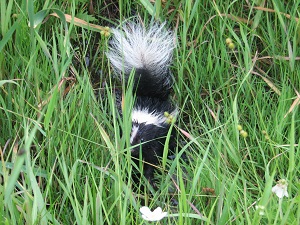
The Vermont Fish & Wildlife Department is again urging Vermonters to leave wildlife in the wild where they belong. The department is receiving calls and emails from individuals who are temporarily caring for wildlife, mostly young skunks, woodchucks, raccoons, foxes and other mammals, only to find wildlife rehabilitation facilities are full and not accepting additional animals.
“Most young wildlife should be left in the wild as the adults, although not visible, are likely close by. In addition, taking in any wild animal is not only unsafe, it is illegal in Vermont,” says Vermont Fish & Wildlife Department furbearer biologist Kim Royar. “We have seen a tremendous increase in numbers of people who have taken in young wild animals recently, but these folks are finding that wildlife rehabilitation centers are at maximum capacity and are turning away new animals.”
Having been removed from their mothers and unable to care for themselves, these baby animals often have to be euthanized, leaving their temporary caretakers and their families heartbroken despite their good-willed attempts to help wildlife.
The department would also like to remind the public that Vermont State Game Wardens typically only respond to wildlife calls if a sick, injured or abandoned animal is already safely contained or otherwise poses an immediate threat to human health and safety. Handling wildlife can be dangerous, but certain animals, like rabies-vector species such as raccoons, foxes or skunks are particularly problematic, because the only way to test these animals for the rabies virus is to euthanize them.
People who have been exposed to rabies must be treated with expensive rabies shots which are often not covered by medical insurance providers.
And while wild animals may carry additional diseases that can be passed to humans, wildlife agencies across the country are currently scrambling to determine whether or not the COVID-19 virus can be transmitted to our native wildlife populations. This uncertainty is also forcing wildlife rehabilitation facilities and animal control specialists to reduce or cease their activities on potentially susceptible species during the global pandemic.
For more information about rabies and staying safe among wildlife, please visit the Vermont Department of Health’s website: https://www.healthvermont.gov or call the Vermont Rabies Hotline at 1-800-4RABIES (1-800-472-2437).
As Vermonters are spending more time at home this year, they are encountering wildlife on their properties like never before. And just like with your family, friends and neighbors, Vermont Fish & Wildlife encourages the public to practice safe social distancing which extends to appreciating wildlife from a safe distance. Here are a few simple additional considerations to help keep yourself and wildlife safe:
Deer and moose nurse their young at different times during the day, and often leave their young alone for long periods of time. These animals are not lost. Their mother knows where they are and will return.
Young birds on the ground may have left their nest, but their parents will still feed them.
Young animals such as fox and raccoon will often follow their mother. The mother of a wildlife youngster is usually nearby and just out of sight to a person; your presence alone may keep the mother from returning to her young.
Many wildlife species will not feed or care for their young when people are close by. Obey signs that restrict access to wildlife nesting areas, including hiking trails that may be temporarily closed.
Keep domestic pets indoors, leashed or fenced in. Dogs and cats kill many baby animals each year.
Avoid projects that remove trees, shrubs and dead snags that contain nests during the spring and summer.
For Immediate Release: June 11, 2020
Media Contact: Kim Royar, 802-747-8412, Mark Scott 802-777-
